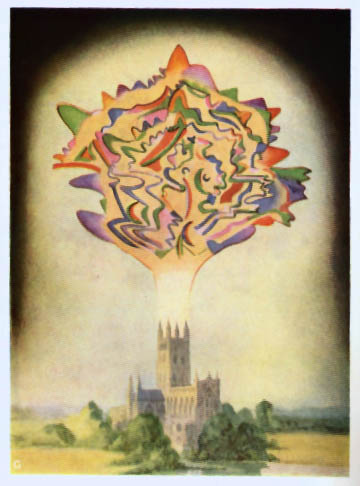



“The drawing and the painting of the Thought-Forms observed by Mr. Leadbeater and myself, or by both of us together, has been done by three friends—Mr John Varley, Mr Prince, and Miss Macfarlane… To paint in earth’s dull colours the forms clothed in the living light of other worlds is a hard and thankless task… they needed coloured fire, and had only ground earths.”
“It is our earnest hope… as it is our belief… that this little book will serve as a striking moral lesson to every reader, making him realise the nature and power of his thoughts, acting as a stimulus to the noble, a curb on the base.”
The Theosophical Society, like other spiritual and occult organisations of the time and earlier, helped form the foundations of what was to become the current New Age or—according to Alice Bailey, writing in the early-mid 20th century—the “new world religion” (which it seems to have now become, albeit often in a popularised form). Idealistic and humanitarian, Annie Besant was also a tireless campaigner for social issues such as contraception and women’s rights. Like the current New Age, these movements were inspired by recent scientific discoveries,2 that were sometimes misappropriated to justify complex symbologies concerning the nature of life, the universe and… everything. In their eagerness to press science to the spiritual cause they sometimes supported what later turned out to be scientific dead-ends; the ‘ether’ (a supposed medium for radio transmission) became a Theosophical commonplace and is now firmly established in New Age thought. Yet their inquiries into the nature of things attracted many creative minds of the day and, long before Star Trek, they envisioned a just and equal society where ‘man’ would overcome “his base instincts” and enter what might now be called a transhuman3 phase of evolution.
The magic of today is the science of tomorrow might be a phrase Theosophists invented. The marriage of Hindu philosophy, world religions, ‘channelling’, occult thought, prehistory and science spawned generations of similar fusions until today, when the most exciting scientific thinking nudges up against ideas that would not have looked out of place in a Theosophical treatise. In this climate, even prominent researchers don’t always conceal their spiritual beliefs.
The original Theosophy may have been flawed, with its modernist presumptions about linear progress and hierarchical grades of existence—whatever the real thing is, it has to be far messier—but is most dated in its dualism. Gnostic-like divisions between the ‘material world’ and the ‘subtle realms’ open up philosophical schisms founded on ancient spiritual views that probably evolved from a desire to escape or justify the unpleasant limitations of physical existence; the origins of which probably predate Plato’s famous cave story. Since that time, the boundaries of human perception have been extended by revelations that demonstrate just how non-material matter actually is at a sub-atomic level (which has in turn spawned a whole new wave of sci-spirituality). In the more inclusive philosophies of the current era, this split has been healed in a holistic view of the human condition that includes and respects both body and spirit. But maybe that's simply become easier now; at least for those fortunate enough to enjoy the material comfort and spare time that was far less accessible in the late 19th century.